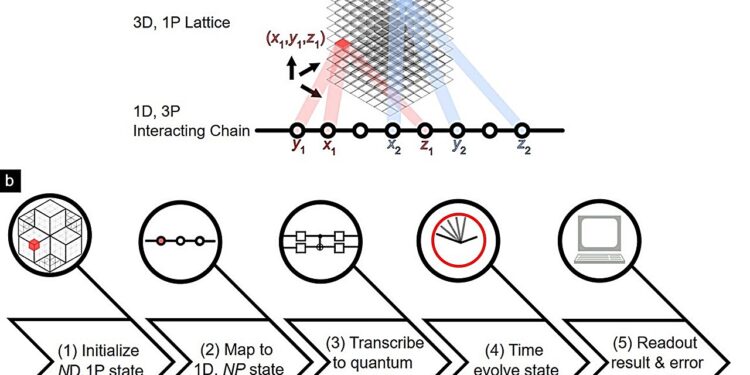By compressing quantum information in a large three-dimensional (3D) single-particle (1P) lattice system into a one-dimensional (1D) spin chain with three interacting particles (3P), quantum materials can be accurately simulated on current quantum computers using a series of techniques developed in-house (1)-(5). Credit: Nature Communications
Researchers from the National University of Singapore (NUS) have successfully simulated higher-order topological (HOT) networks with unprecedented accuracy using digital quantum computers. These complex network structures can help us understand advanced quantum materials with robust quantum states, which are highly sought after in various technological applications.
The study of topological states of matter and their HOT counterparts has attracted considerable attention among physicists and engineers. This fervent interest stems from the discovery of topological insulators, materials that conduct electricity only on the surface or edges, while their interiors remain insulating.
Due to the unique mathematical properties of topology, electrons flowing along the edges are not hindered by defects or deformations in the material. Devices made from such topological materials therefore have great potential for more robust signal transport or transmission technology.
Using quantum many-body interactions, a team of researchers led by Lee Ching Hua, Assistant Professor in the Department of Physics at NUS, has developed a scalable approach to encode large, high-dimensional HOT lattices, representative of real topological materials, into the simple spin chains that exist in today’s digital quantum computers. Their approach exploits the exponential amounts of information that can be stored using quantum computer qubits, while minimizing quantum computing resource requirements in a noise-robust manner.
This breakthrough opens a new avenue in the simulation of advanced quantum materials using digital quantum computers, unlocking new possibilities in the engineering of topological materials. The results of this research were published in the journal Nature Communications.
Quantum processor measurements of HOT corner modes on a 4D tesseract lattice. Credit: Nature Communications (2024). DOI: 10.1038/s41467-024-49648-5
Professor Lee said: “Existing state-of-the-art studies in the field of quantum advantages are limited to very specific problems. Finding new applications for which quantum computers offer unique advantages is the main motivation for our work.”
“Our approach allows us to explore the complex signatures of topological materials on quantum computers with a level of precision that was previously unattainable, even for hypothetical materials existing in four dimensions,” added Professor Lee.
Despite the limitations of current noisy intermediate-scale quantum (NISQ) devices, the team is able to measure the dynamics of topological states and the protected mid-range spectra of higher-order topological networks with unprecedented precision, thanks to advanced error mitigation techniques developed in-house. This advance demonstrates the potential of current quantum technology to explore new frontiers in materials engineering.
The ability to simulate high-dimensional HOT lattices opens new research directions in quantum materials and topological states, suggesting a potential path to achieving true quantum advantage in the future.
More information:
Jin Ming Koh et al, Realization of higher-order topological networks on a quantum computer, Nature Communications (2024). DOI: 10.1038/s41467-024-49648-5
Provided by National University of Singapore
Quote: Higher-order topological simulation opens new potential in quantum computers (2024, August 30) retrieved August 30, 2024 from
This document is subject to copyright. Apart from any fair dealing for the purpose of private study or research, no part may be reproduced without written permission. The content is provided for informational purposes only.



